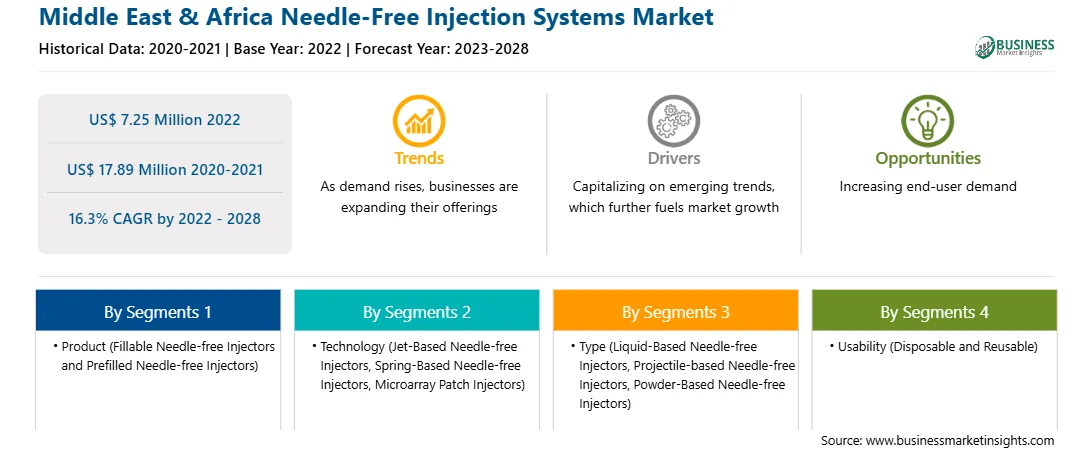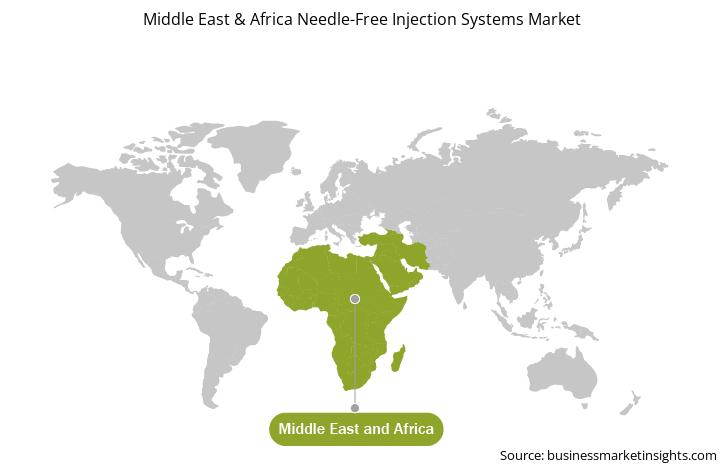Needlestick injuries (NSIs) are one of the major concerns for most healthcare providers, and it is considered one of the most serious health and safety threats. The pooled prevalence of needlestick injuries among healthcare workers in 2020 was 32.4%. Further, according to the article published by the International Journal of Environment Research & Public Health 2022, the incidence of NSIs in Saudi Arabia is highest among physicians (36%), followed by nurses (34.8%), dentists (29.2%), and medical technologists (21.1%). Thus, above-mentioned factors are boosting the growth of the Middle East & Africa needle-free injection systems market.
The Middle East & Africa needle-free injection system market is segmented into the UAE, Saudi Arabia, South Africa, and the Rest of Middle East & Africa. Saudi Arabia holds the largest share of the Middle East & Africa needle-free injection systems market owing to several factors such as increasing strategic initiatives by market players for launching their products in the region, rising incidence of chronic diseases, and growing healthcare infrastructure along with the increasing need for vaccines in the region.
Saudi Arabia is one of the fastest-growing regions in the Middle East & Africa, whose growth is driven by the increasing prevalence of chronic diseases such as diabetes, cardiovascular diseases, cancer, and autoimmune diseases. Rising awareness of health issues and growing adoption of needle-free injections for injectable drugs are the factors fueling the needle-free injection systems market growth. The burden of chronic diseases is significant in Saudi Arabia, which is expected to increase the demand for the Middle East & Africa needle-free injection systems market.
The World Health Organization has ranked Saudi Arabia as having the second-highest rate of diabetes in the Middle East and seventh-highest in the world. It is estimated that 7 million have diabetes and more than 3 million have pre-diabetes in Saudi Arabia. Over the last two decades, in Saudi, there has been a rise in the expenses of healthcare and treatment of diabetes by more than 500%. In diabetic patients, needle-free injectors can be used to inject insulin as a painless and easy-to-use treatment. Thus, the demand for needle-free injection systems is increasing, boosting the Middle East & Africa needle-free injection systems market growth.
Strategic insights for the Middle East & Africa Needle-Free Injection Systems provides data-driven analysis of the industry landscape, including current trends, key players, and regional nuances. These insights offer actionable recommendations, enabling readers to differentiate themselves from competitors by identifying untapped segments or developing unique value propositions. Leveraging data analytics, these insights help industry players anticipate the market shifts, whether investors, manufacturers, or other stakeholders. A future-oriented perspective is essential, helping stakeholders anticipate market shifts and position themselves for long-term success in this dynamic region. Ultimately, effective strategic insights empower readers to make informed decisions that drive profitability and achieve their business objectives within the market.

| Report Attribute | Details |
|---|---|
| Market size in 2022 | US$ 7.25 Million |
| Market Size by 2028 | US$ 17.89 Million |
| Global CAGR (2022 - 2028) | 16.3% |
| Historical Data | 2020-2021 |
| Forecast period | 2023-2028 |
| Segments Covered |
By Product
|
| Regions and Countries Covered | Middle East and Africa
|
| Market leaders and key company profiles |
The geographic scope of the Middle East & Africa Needle-Free Injection Systems refers to the specific areas in which a business operates and competes. Understanding local distinctions, such as diverse consumer preferences (e.g., demand for specific plug types or battery backup durations), varying economic conditions, and regulatory environments, is crucial for tailoring strategies to specific markets. Businesses can expand their reach by identifying underserved areas or adapting their offerings to meet local demands. A clear market focus allows for more effective resource allocation, targeted marketing campaigns, and better positioning against local competitors, ultimately driving growth in those targeted areas.

The Middle East & Africa needle-free injection systems market is segmented on the basis of product, technology, type, durability, and country. Based on product, the Middle East & Africa needle-free injection systems market is bifurcated into fillable needle-free injectors and prefilled needle-free injectors. The fillable needle-free injectors segment held a larger share of the market in 2022.
Based on technology, the Middle East & Africa needle-free injection systems market is segmented into jet-based needle-free injectors, spring-based needle-free injectors, microarray patch injectors, and others. The jet-based needle-free injectors segment registered the largest share of the market in 2022.
Based on type, the Middle East & Africa needle-free injection systems market is segmented into liquid-based needle-free injectors, projectile-based needle-free injectors, and powder-based needle-free injectors. The liquid-based needle-free injectors segment registered the largest share of the market in 2022.
Based on durability, the Middle East & Africa needle-free injection systems market is bifurcated into disposable and reusable. The reusable segment held a larger share of the market in 2022.
Based on site of delivery, the Middle East & Africa needle-free injection systems market is segmented into subcutaneous injectors, intramuscular injectors, and intradermal injectors. The subcutaneous injectors segment held the largest share of the market in 2022.
Based on application, the Middle East & Africa needle-free injection systems market is segmented into vaccine delivery, insulin delivery, oncology, pain management, dermatology, and others. The vaccine delivery segment held the largest share of the market in 2022.
Based on end user, the Middle East & Africa needle-free injection systems market is segmented into hospitals, home care settings, research laboratories, pharmaceutical and biotechnology companies, and others. The hospitals segment held the largest share of the market in 2022.
Based on country, the Middle East & Africa needle-free injection systems market is segmented into Saudi Arabia, South Africa, the UAE, and the Rest of Middle East & Africa. Saudi Arabia dominated the market in 2022.
Aijex Pharma International Inc., Crossject, Ferring B.V., and Zealand Pharma A/S are the leading companies operating in the needle-free injection systems market in the Middle East & Africa.
The Middle East & Africa Needle-Free Injection Systems Market is valued at US$ 7.25 Million in 2022, it is projected to reach US$ 17.89 Million by 2028.
As per our report Middle East & Africa Needle-Free Injection Systems Market, the market size is valued at US$ 7.25 Million in 2022, projecting it to reach US$ 17.89 Million by 2028. This translates to a CAGR of approximately 16.3% during the forecast period.
The Middle East & Africa Needle-Free Injection Systems Market report typically cover these key segments-
The historic period, base year, and forecast period can vary slightly depending on the specific market research report. However, for the Middle East & Africa Needle-Free Injection Systems Market report:
The Middle East & Africa Needle-Free Injection Systems Market is populated by several key players, each contributing to its growth and innovation. Some of the major players include:
The Middle East & Africa Needle-Free Injection Systems Market report is valuable for diverse stakeholders, including:
Essentially, anyone involved in or considering involvement in the Middle East & Africa Needle-Free Injection Systems Market value chain can benefit from the information contained in a comprehensive market report.